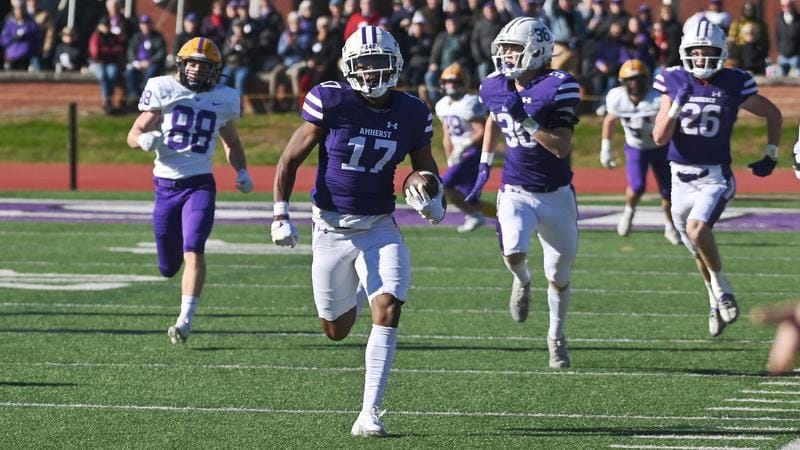Before the Game: Analysis of the 2025 Homecoming Matchup
Managing Sports Editor Joey Supik ’27 provides a rundown of what you need to know before the 2025 Homecoming football game.

The Homecoming football game: Nothing brings together the Amherst community, past and present, quite like this event. You may be an avid football fan or getting acquainted with the team for the first time, but after reading this article, you’ll be an expert on what to expect from both sides of the field.
Amherst faces off against Williams on Saturday at 12 p.m. in the Biggest Little Game in America, one of the oldest football rivalries in the country. The Mammoths and Ephs first faced off in 1884, playing annually thereafter, except during the Covid season. Williams leads the rivalry overall with 76 wins to Amherst’s 57, with five games ending in a tie. Last season, in our non-Homecoming and away matchup with Williams, the Ephs shut out the Mammoths, winning 21-0. Two seasons ago, the last time Amherst hosted Williams at Pratt Field, the Mammoths took the win in a thrilling 21-14 showdown.
This season, Williams has a 5-3 record and is third overall in the NESCAC, while Amherst is 4-4 and fifth in the conference. While neither team can win the NESCAC, regardless of who wins this Saturday, both sides will be fighting for a better finish. This game is when we annually set aside regular-season records, and the rivalry match between these two institutions turns into a battle for school pride. It’s also the senior players’ final game of their collegiate career, so the emotions run high on who gets to end their career on a high note. With the stakes set, let’s see how both sides stack up.
Williams poses numerous challenges for Amherst to overcome, including its efficient offensive schemes and decent defensive prowess. For starters, Williams has 1,605 rushing yards this year, the most in the NESCAC. Williams running back Jon Oris is second in the league in rushing yards with 782. Quarterback Owen Johansen, originally a tight end, has 495 rushing yards, the fifth-most in the NESCAC. Johansen also averages the most rushing yards per attempt out of any player in the NESCAC with 50 or more attempts. Expect Oris and Johansen to run the ball a lot and possibly find success while they’re at it.
Moreover, Johansen has been the engine behind Williams’ success this season. The quarterback has scored seven rushing touchdowns and thrown 10 touchdowns, while throwing a little over 1,000 yards. While Johansen is not an elite quarterback in terms of his passing statistics, he makes up for it with his strong rushing abilities and poise, boasting the highest passer efficiency rating in the league. Johansen has a favorite receiving target, wide receiver Zach Falls, who has over 700 receiving yards and eight caught touchdowns, leading the NESCAC in both categories, while no other player on the team has more than 150 receiving yards. If the ball is thrown, it will likely be in Falls’ direction and possibly for a big play. The team’s offensive efficiency is partly due to the diverse rushing and passing offensive schemes, and partly due to allowing only four sacks this season on its quarterbacks, with three of them happening last week against Wesleyan University.
Beyond the offense, Williams’ defense is fairly imposing. Williams leads the NESCAC in sacks, forced fumbles, fumbles recovered, and is tied for the most interceptions. The team has the fourth-best rushing defense, letting up only 788 rushing yards this season. Looking at individual statistics, Williams has a few standout defensive players. Linebackers Zakkai Moore and Luke Mangini are fourth and fifth in total tackles, and second and third in tackles for loss in the NESCAC, respectively. Defensive lineman Ben Yedid has six sacks, the second-most in the league, along with a league-leading three forced fumbles. The last highlight player is safety George Papadopoulos, who leads the league in passes broken up and is tied for the most interceptions. Anticipate Moore and Mangini to be the first players to reach the ball, Yedid to attempt to tackle our quarterback, and Papadopoulos to challenge Amherst’s number one receiving threat.
Despite these challenges, Amherst matches up quite well against Williams. Amherst’s third-most passing yards and most completed passes in the league will likely fare well against Williams’ league-worst passing defense, letting up 2,227 passing yards and 16 touchdowns on the season. Amherst quarterback Marek Hill ’28 has 1,863 passing yards and 11 passing touchdowns this year, and has attempted more passes than any other quarterback in the league this year. In the receiving game, Amherst has wide receivers Carter Jung ’26 and Christian Moore ’27, who have the fourth and ninth-most receiving yards in the NESCAC, respectively.
Williams may not be prepared for Amherst’s relentless passing offense, and the team certainly doesn’t have the stats to prove otherwise. The last important note in the Mammoths’ offense is the success the offensive line has found this season. Amherst has only let up seven sacks on the quarterback, the second-least in the league, and it’s due to great work by the offensive linemen these past eight games. For the Amherst offense to be successful this week, it’ll need impressive blocking from these offensive linemen, heightened pocket awareness that Hill has demonstrated this year, and confidence in our players to make great plays in the passing game.
Regarding the Williams offense, while the Ephs may have a proven rushing duo in Oris and Johansen, the Mammoths have an equally elite rushing defense. Amherst has only let up 580 rushing yards this season, the second-least in the league, and a league-low five rushing touchdowns. In the NESCAC, Amherst is second in sacks and third in fumbles forced and recovered. Amherst has the second-lowest opponent third-down and fourth-down conversion rate, which will greatly help in crucial turnover and possession-changing moments this Saturday. Some prominent Amherst defensive figures include linebacker Carson Skotak ’27, defensive back/linebacker Luke Harmon ’26, defensive lineman Wyatt Morgan ’28, and defensive back Niles Riding ’26. Skotak leads Amherst in total tackles and fumbles recovered, Harmon leads in tackles for loss and forced fumbles, Morgan is the team’s sack leader, and Riding leads in passes defended. When Williams’ offense starts to show weakness, expect one of these players to make a big play.
What matters most in this game, however, is the energy we bring as supporters to the Homecoming match. Williams has a long tradition of “The Walk,” which involves their team parading through the town’s main — and possibly only — street after every Homecoming win since 1971. The team’s late coach, Renzie Lamb, famously said, “If you want to be happy forever, beat Amherst,” which accurately describes the attitudes of Williams players and fans towards this game. The Ephs have shown unrelenting spirit and passion for their institution through this game, and we need to step up and bring even more energy and support for the Mammoths. The Homecoming game is supposed to bring Amherst old and new together to celebrate both the institution and a special, age-old rivalry.
Get outside this Saturday, cheer on Amherst, and make Williams miserable for a lifetime.





Comments ()